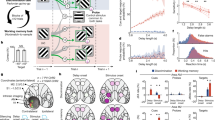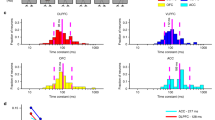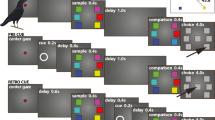Abstract
Adaptive sequential behaviors rely on the bridging and integration of temporally separate information for the realization of prospective goals. Corvids’ remarkable behavioral flexibility is thought to depend on the workings of the nidopallium caudolaterale (NCL), a high-level avian associative forebrain area. We trained carrion crows to remember visual items for three alternating delay durations in a delayed match-to-sample task and recorded single-unit activity from the NCL. Sample-selective delay activity, a correlate of visual working memory, was maintained throughout different working memory durations. Delay responses remained selective for the same preferred sample item across blocks with different delay durations. However, selectivity strength decreased with increasing delay durations, mirroring worsened behavioral performance with longer memory delays. Behavioral relevance of delay activity was further evidenced by reduced encoding of the preferred sample item during error trials. In addition, NCL neurons adapted their time-dependent discharges to blocks of different memory durations, so that delay duration could be successfully classified based on population activity a few trials after the delay duration switched. Therefore, NCL neurons not only maintain information from individual trials, but also keep track of the duration for which this information is needed in the context of the task. These results strengthen the role of corvid NCL in maintaining working memory for flexible control of temporally extended goal-directed behavior.







Similar content being viewed by others
References
Barak O, Tsodyks M, Romo R (2010) Neuronal population coding of parametric working memory. J Neurosci 30:9424–9430
Barak O, Sussillo D, Romo R, Tsodyks M, Abbott LF (2013) From fixed points to chaos: three models of delayed discrimination. Prog Neurobiol 103:214–222
Bermudez MA, Schultz W (2014) Timing in reward and decision processes. Philos Trans R Soc B 369:20120468
Brecht KF, Wagener L, Ostojić L, Clayton NS, Nieder A (2016) Comparing the face inversion effect in crows and humans. J Comp Physiol A. https://doi.org/10.1007/s00359-017-1211-7
Brody CD, Hernández A, Zainos A, Romo R (2003) Timing and neural encoding of somatosensory parametric working memory in macaque prefrontal cortex. Cereb Cortex 13:1196–1207
Browning R, Overmier JB, Colombo M (2010) Delay activity in avian prefrontal cortex—sample code or reward code? Eur J Neurosci 33:726–735
Cover T, Hart P (1967) Nearest neighbor pattern classification. IEEE Trans Inf Theor 13:21–27. https://doi.org/10.1109/TIT.1967.1053964
Diekamp B, Kalt T, Güntürkün O (2002) Working memory neurons in pigeons. J Neurosci 22:RC210
Ditz HM, Nieder A (2015) Neurons selective to the number of visual items in the corvid songbird endbrain. Proc Natl Acad Sci USA 112:7827–7832
Ditz HM, Nieder A (2016a) Numerosity representations in crows obey the Weber–Fechner law. Proc Biol Sci 283(1827):20160083
Ditz HM, Nieder A (2016b) Sensory and working memory representations of small and large numerosities in the crow endbrain. J Neurosci 36:12044–12052
Divac I, Mogensen J, Björklund A (1985) The prefrontal “cortex” in the pigeon. Biochemical evidence. Brain Res 332:365–368
Durstewitz D, Kröner S, Güntürkün O (1999) The dopaminergic innervation of the avian telencephalon. Prog Neurobiol 59:161–195
Fuster JM (1973) Unit activity in prefrontal cortex during delayed-response performance: neuronal correlates of transient memory. J Neurophysiol 36:61–78
Fuster JM (2001) The prefrontal cortex—an update: time is of the essence. Neuron 30:319–333
Fuster JM (2008) The prefrontal cortex, 4th edn. Academic Press, New York
Fuster JM, Alexander GE (1971) Neuron activity related to short-term memory. Science 173:652–654
Genovesio A, Tsujimoto S, Wise SP (2006) Neuronal activity related to elapsed time in prefrontal cortex. J Neurophysiol 95:3281–3285
Ghose GM, Maunsell JHR (2002) Attentional modulation in visual cortex depends on task timing. Nature 419:616–620
Goldman-Rakic PS (1995) Cellular basis of working memory. Neuron 14:477–485
Goto K, Watanabe S (2009) Visual working memory of jungle crows (Corvus macrorhynchos) in operant delayed matching-to-sample. Jpn Psychol Res 51:122–131
Güntürkün O (2005) The avian “prefrontal cortex” and cognition. Curr Opin Neurobiol 15:686–693
Hartmann B, Güntürkün O (1998) Selective deficits in reversal learning after neostriatum caudolaterale lesions in pigeons: possible behavioral equivalencies to the mammalian prefrontal system. Behav Brain Res 96:125–133
Hoffmann A, Rüttler V, Nieder A (2011) Ontogeny of object permanence and object tracking in the carrion crow, Corvus corone. Anim Behav 82:359–367
Janssen P, Shadlen MN (2005) A representation of the hazard rate of elapsed time in macaque area LIP. Nat Neurosci 8:234–241
Kalenscher T, Windmann S, Diekamp B, Rose J, Güntürkün O, Colombo M (2005) Single units in the pigeon brain integrate reward amount and time-to-reward in an impulsive choice task. Curr Biol 15:594–602
Kalenscher T, Ohmann T, Windmann S, Freund N, Güntürkün O (2006) Single forebrain neurons represent interval timing and reward amount during response scheduling. Eur J Neurosci 24:2923–2931
Karten HJ, Hodos W (1967) A stereotaxic atlas of the brain of the pigeon: (Columba livia). Johns Hopkins Press, Baltimore
Kojima S, Goldman-Rakic PS (1982) Delay-related activity of prefrontal neurons in rhesus monkeys performing delayed response. Brain Res 248:43–49
Lengersdorf D, Pusch R, Güntürkün O, Stüttgen MC (2014) Neurons in the pigeon nidopallium caudolaterale signal the selection and execution of perceptual decisions. Eur J Neurosci 40:3316–3327
Miller EK, Cohen JD (2001) An integrative theory of prefrontal cortex function. Annu Rev Neurosci 24:167–202
Miller EK, Erickson CA, Desimone R (1996) Neural mechanisms of visual working memory in prefrontal cortex of the macaque. J Neurosci 16:5154–5167
Mogensen J, Divac I (1993) Behavioural effects of ablation of the pigeon-equivalent of the mammalian prefrontal cortex. Behav Brain Res 55:101–107
Moll FW, Nieder A (2014) The long and the short of it: rule-based relative length discrimination in carrion crows, Corvus corone. Behav Process 107:142–149
Moll FW, Nieder A (2015) Cross-modal associative mnemonic signals in crow endbrain neurons. Curr Biol 25:2196–2201
Moll FW, Nieder A (2017) Modality-invariant audio-visual association coding in crow endbrain neurons. Neurobiol Learn Mem 137:65–76
Nieder A (2016) The neuronal code for number. Nat Rev Neurosci 17:366–382
Nieder A (2017) Inside the corvid brain—probing the physiology of cognition in crows. Curr Opin Behav Sci 16:8–14
Niki H, Watanabe M (1979) Prefrontal and cingulate unit activity during timing behavior in the monkey. Brain Res 171:213–224
Rainer G, Rao SC, Miller EK (1999) Prospective coding for objects in primate prefrontal cortex. J Neurosci 19:5493–5505
Roesch MR, Olson CR (2005) Neuronal activity dependent on anticipated and elapsed delay in macaque prefrontal cortex, frontal and supplementary eye fields, and premotor cortex. J Neurophysiol 94:1469–1497
Sakurai Y, Takahashi S, Inoue M (2004) Stimulus duration in working memory is represented by neuronal activity in the monkey prefrontal cortex. Eur J Neurosci 20:1069–1080
Schultz W (2006) Behavioral theories and the neurophysiology of reward. Ann Rev Psychol 57:87–115. https://doi.org/10.1146/annurev.psych.56.091103.070229
Stokes MG, Kusunoki M, Sigala N, Nili H, Gaffan D, Duncan J (2013) Dynamic coding for cognitive control in prefrontal cortex. Neuron 78:364–375
Sugase-Miyamoto Y, Liu Z, Wiener MC, Optican LM, Richmond BJ (2008) Short-term memory trace in rapidly adapting synapses of inferior temporal cortex. PLoS Comput Biol 4(5):e1000073
Veit L, Nieder A (2013) Abstract rule neurons in the endbrain support intelligent behaviour in corvid songbirds. Nat Commun 4:2878
Veit L, Hartmann K, Nieder A (2014) Neuronal correlates of visual working memory in the corvid endbrain. J Neurosci 34:7778–7786
Veit L, Pidpruzhnykova G, Nieder A (2015) Associative learning rapidly establishes neuronal representations of upcoming behavioral choices in crows. Proc Natl Acad Sci USA 112:15208–15213
Veit L, Hartmann K, Nieder A (2017a) Spatially-tuned neurons in corvid nidopallium caudolaterale signal target position during visual search. Cereb Cortex 27:1103–1112
Veit L, Pidpruzhnykova G, Nieder A (2017b) Learning recruits neurons representing previously established associations in the corvid endbrain. J Cogn Neurosci 29:1712–1724
Wagener L, Nieder A (2017) Encoding of global visual motion in the Nidopallium caudolaterale of behaving crows. Eur J Neurosci 45:267–277
White KG (1985) Characteristics of forgetting functions in delayed matching-to-sample. J Exp Anal Behav 45:161–174
Acknowledgements
This work was supported by a Ph.D. fellowship from the German National Academic Foundation to L.V. and by a DFG Grant NI 618/6-1 to A.N.
Author information
Authors and Affiliations
Contributions
KH and AN designed experiments, KH performed experiments, KH and LV analyzed data, and LV, KH, and AN wrote the paper.
Corresponding author
Rights and permissions
About this article
Cite this article
Hartmann, K., Veit, L. & Nieder, A. Neurons in the crow nidopallium caudolaterale encode varying durations of visual working memory periods. Exp Brain Res 236, 215–226 (2018). https://doi.org/10.1007/s00221-017-5120-3
Received:
Accepted:
Published:
Issue Date:
DOI: https://doi.org/10.1007/s00221-017-5120-3




